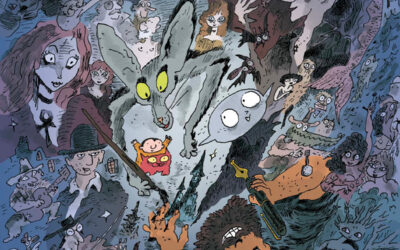Louis-Léopold Boilly (1761-1845), John who laughs, around 1808-1810. Oil on canvas, 21,5 x 17 cm. Private collection © Guillaume Benoît.
A curiously little-known gem of a museum – in a sense, good for us! – the Cognacq-Jay museum is inaugurating a stimulating exhibition dedicated to one of the most unknown French artists of the 18th century: Louis-Léopold Boilly (1761-1845). Virtuoso, prolific and unclassifiable, this autodidact established himself posthumously as one of the best chroniclers of popular Paris, its streets, its inhabitants, its effervescence.
Originally from the North of France, Boilly arrived in Paris at the age of 24 in 1785, with only his brushes and immense talent. From one revolution to another (1789 and 1848), he became, for six decades, the facetious, precise and prolific chronicler of the capital, which fascinated him.

Louis-Léopold Boilly (1761-1845), Two young friends kissing, around 1789-1793. oil on canvas, 42,5 x 35 cm. Wiltshire, The Ramsbury Foundation © The Ramsbury Manor Foundation
Disinterested in the big story, he focuses on the scenes of ordinary life: the arrival of a post coach near the current Place des Victoires, the crowd during a free distribution of wine at the occasion of the King's Day on the Champs-Élysées, the stampede in front of the entrance to the Ambigu-Comique theater [now defunct] on the Grands Boulevard or even children attending a Guignol show.

Louis-Léopold Boilly (1761-1845), The traveling Polichinelle show, 1832. Oil on canvas, 33 x 41 cm. Wiltshire, The Ramsbury Manor Foundation © The Ramsbury Manor Foundation.
Some paintings speak directly to us about the Marais or its immediate surroundings, such as this oil from the women's prison on rue Meslay (3rd) or the theater at Porte Saint-Martin (10th). Vagabonds, policemen, porters, street vendors, bourgeois, prostitutes: all strata of society are represented in these abundant images where the artist represents himself, in the manner of Alfred Hitchcock's appearances in his films - we think of course, also, to the British comic-game Where did Charlie go?

Louis-Léopold Boilly (1761-1845), The incredible walk, circa 1797. Oil on panel, 39,3 x 51 cm. Private collection © Guillaume Benoît.
Little-known, original and exciting, Boilly's work is presented for the first time in such a complete way. The exhibition is, in a way, an extension of the famous Tableau de Paris by Louis-Sébastien Mercier. Published in 1788, this work, well known to lovers of the capital, also described in detail the customs and daily lives of Parisians. A brilliant jack-of-all-trades and formidable caricaturist, Boilly also greatly influenced Honoré Daumier, painter, sculptor and caricaturist born fifty years after him (in 1808).
Curator Annick Lemoine, whose last exhibition is before joining the Petit Palais, is ending her four years at Cognacq-Jay in style. And leaves us in wonderful company with this sacred number that we didn't know but won't soon forget: Louis-Léopold Boilly.
Boilly, Parisian chronicles
Cognac-Jay Museum
until June 26, 2022
8 Rue Elzevir, 75003 Paris
Open daily from 10h to 18h

Louis-Léopold Boilly (1761-1845), Grimaces, circa 1823. Lithograph, black print, colored print, 38 x 27,5 cm. Private collection © Guillaume Benoît.
Text: Axel G.
17. 02.22
THERE ARE LOTS OF MUSEUMS HERE
Annie Ernaux, the literature of reality at the MEP
The 2022 Nobel Prize-winning writer has been interested in photography for a long time, notably in the text “the use of photography”, a four-handed story published in 2006. At the European House of Photography, on the banks of the Seine , the exhibition Exteriors - Annie Ernaux & Photography flourishes until May 26, 2024.
The Weegee enigma, extreme photographer
American photojournalist from the 1930s and 50s, famous for his black and white photos of nightlife in New York, Weegee takes this nickname as a nod to the spirit board, the Ouija board. Because he proclaims himself a “psychic photographer” with the 3rd eye.
Joann Sfar featured at MAHJ
Who doesn’t know the comic strip “The Rabbi’s Cat”? Its creator, Joann Sfar, was born in Nice in 1971. In this retrospective at the Museum of Art and History of Judaism in the heart of the Marais, the first of its kind, we will see many original plates presented in images by the famous cat .
NOW ON THE MOOD MARSH
Victor Hugo, the writer with a thousand talents
Born in 1802, Victor Hugo became a social writer, a playwright, a poet, a novelist and a romantic designer. Nicknamed the man-ocean then the man-century, he is a political figure and a committed intellectual. He found success with Notre-Dame-de-Paris in 1831 and with Les Misérables in 1862.
The best tattoo parlors in Marais
Tattooing, an age-old practice, has long been the prerogative of convicts, dock workers, the underworld and sailors. Although it has become democratized, now affecting all profiles and concerning one in five French people, including 16% women compared to 10% men, it still remains taboo due to its definitive and transgressive nature.
Juliette Drouet actress, muse and mistress of Victor Hugo
At 14 rue Sainte-Anastase, from 1836 to 45 and at 12 from 1845 to 48, a few hundred meters from Place des Vosges, lived the muse and lover of Victor Hugo, Juliette Drouet née Julienne Gauvain.







